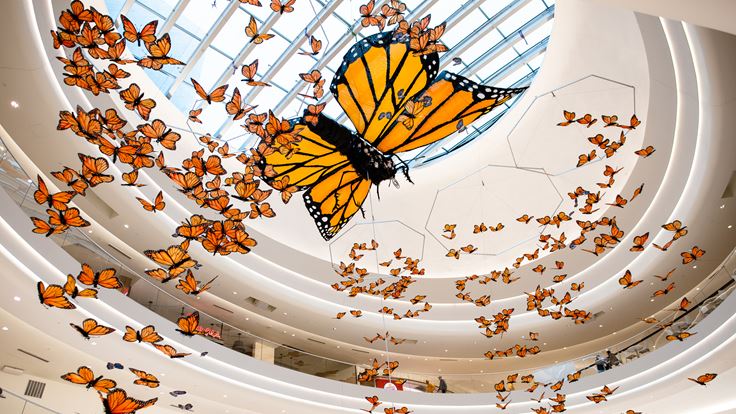Kaleidoscope at MOA®
Christopher Lutter-Gardella has created a magnificent suspended installation at Mall of America consisting of a majestic 30-foot Monarch butterfly surrounded by more than 300 smaller butterflies. The installation is entitled “Kaleidoscope” and will share the critical story about the decline of the monarch butterfly and other pollinators with the hope of educating guests on how they can make a difference to help address this situation.
Kaleidoscope was created using materials pulled from the waste stream. What you might see as a plastic spoon, artist Christopher Lutter-Gardella sees as an eye of a monarch butterfly. Over 600 spoons were used to create the eyes of the smaller butterflies above you. When you start to see things differently, we realize the smallest changes truly can have a big impact.
Artist Statement:
In the Artist Statement for the opening of this exhibit, I proposed that we consider the butterfly as a reminder of our interconnectedness, and indeed, of our utter dependency-upon even the smallest and most vulnerable among us. That if we don’t care for them (butterflies, bees, bears, people) we may not ultimately survive, as a whole. Indeed, our experience with COVID within this past year really demonstrates the point. If we don’t take enough care in how we treat our fellow creatures, the smallest thing will bring-us-down. This can also be demonstrated in the realm of human society. Our caring for the least among us is more than a mere act of charity. It’s an act of survival. But, deep down, it is an act of creation. An affirmation of life.
But is that all there really is to it?
A traditional Papago story speaks of Earth-Maker creating butterflies “to make the hearts of children glad”. And really, aren’t they much more than simply pollinators that pollinate the plants that we so depend-upon?
Through the course of the two previous iterations of this installation, I have, much to my own surprise, witnessed the power of the Butterfly to uplift the hearts and spirits of passersby (particularly through the trials of 2020). They seem to have, by their very nature, played the role of, might I say: Spirit-lifters—bringing an unexpected moment of levity to so many; turning dower expressions into gentle smiles and lit-up eyes; provoking squeals of delight from the littlest people!
I realize it’s about so much more than just pollination.
Butterflies do, indeed, make the hearts of the children glad!
As we emerge from our COVID cocoons, we step into a changed world, as changed people-- many of us asking “How can we live differently”? I would propose we don’t ask that question merely in the restrictive sense of what we cannot do, nor even what we can do, but what we MUST do. We must change (not the butterfly). We must live in a different way—with a deeper appreciation of the interconnectedness of all living things (including to other humans!). Our ecologies, our economies, our human society, our politics. It is ALL connected.
We must, as a human society, allow ourselves to be transformed by this experience.
About the Artist:
Christopher Lutter Gardella is a designer, inventor, theater-maker and community educator whose work revolves around the design, construction and performance of puppets, masks, props, costumes, unique theatrical inventions, kinetic-sets and sculptural installations. He produces his art predominately from waste-stream materials, exploring the unique potentials inherent in the material.
For two decades Lutter-Gardella has been working to inspire and facilitate original thinking in the realms of theatrical, educational and public-art design. A deep and abiding emphasis is placed upon eco-consciousness, material-resourcefulness, collaboration and improvisation.
As a community educator and artist-in-residence, he engages community members in re-purposing various “waste materials” into performable art-works, while deepening their connections to the Earth and to one another.
Lutter-Gardella is the founder and artistic and managing director of Big Animal Productions LLC, a public art production studio. He also manages and directs Puppet Farm Arts, a humble nonprofit community-arts organization, founded back when he used to squat in a barn with his collection of trash and puppets, in Wisconsin. The mission of the Puppet Farm is “to improve the health of human communities and the Earth by teaching people the process of transforming waste materials into imaginative art”.
How You Can Help:
• Plant habitat! Monarch habitat contains the native milkweed that monarch caterpillars rely on, as well as a diversity of other nectar rich flowers.
• Plant a variety of native flowers so you have blooms, and the nectar they provide, growing all season long.
• Monarchs need nectar to migrate in both spring and fall, and to breed in the summer!
• For small spaces, consider a container garden on a balcony or in a shared outdoor space like a patio or front walk.
• Every stem makes a difference—you don’t need a big space to make an impact.
• Minimize use of harmful chemicals on your monarch habitat.
• Participate in citizen science! By contributing your personal observations, you can help researchers learn more about monarchs and their conservation.
Resources
Monarch Joint Venture
US Fish and Wildlife Service: Save the Monarch
Pollinator Partnership
Credits
Design and Artistic Lead: Christopher Lutter-Gardella
Metal Fabrication: Marc Scamp
Colorist / Painters: Julia Lundmark Vanatta / Rachel Madden
Sculptors: Jimmy Grackle/ Tony Chapin
Lead Detail Artist: Richard Parnell
3D Digital Modelling: Quynh Sims-Sheffer
Project Management: Yvonne Freeze
Rigging: Eric Veldey
Rock Star Volunteer: Steve Quiggle
Silk Screening: Moonear Khar
